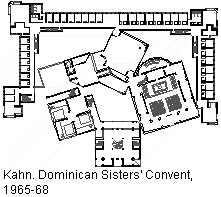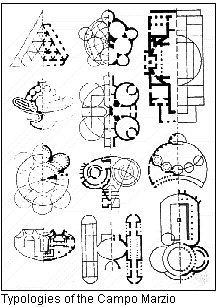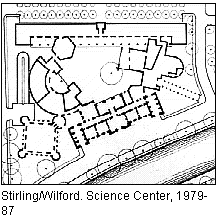Redrawing History - own incentive
1997.08.16
...[the] quote from Scully concerning the Campo Marzio hanging over Kahn's desk. This is very likely the first time I became aware of the existence of Piranesi's Campo Marzio...
Frampton on Kahn
1997.08.28
"The other Enlightenment figure [besides Ledoux] who unquestionably had a lasting impact on Kahn was Piranesi. As Vincent Scully points out, Piranesi's map of Rome [the Ichnographia of the Campo Marzio] was accorded a place of honor above Kahn's desk throughout the entirety of his mature career, and it seems that Piranesi was the essential catalyst which enabled Kahn to synthesize two otherwise irreconcilable aspects of his art: on the one hand, his constant preoccupation with the technical and tectonic authority of the constituent elements from which building had to be composed -- the ducts and piers of service and support; on the other, the capacity to combine and recombine the ruined fragments of a lost heroic past -- ruined both by time and by the delirium of the imagination -- and to posit these fragments, recomposed en miettes, as viable models for a disjunctive future."
Kenneth Frampton, "Louis Kahn and the French Connection," Oppositions 22, 1980.
Scully on Kahn
1997.08.30
"Not so in the studies between the laboratories; their problem demanded a more complicated sequence of Form and Design, and its solution was again characteristic of Kahn. Early shape used were pure derivations from the fanning pattern of the lower peristyle of Domitian's palace of the Palatine or from the "Teatro Marittimo" of Hadrian's Villa. It will be recalled that Wright had long before adapted the plan of the villa as a whole for his Florida Southern College of 1939, and had used shapes from or related to it in later projects, while Le Corbusier had supplemented his sculptural Hellenic impulses with a series of drawings of the Villa's spaces which culminated in his top-lit megara at Ronchamp. More directly, the shapes used by Kahn can be found not only in Choisy but also infinitely repeated in the composite photostat of Giovanni Battista Piranesi's map of Rome, drawn by his for his book on the Campus Martius, probably of 1762, which now hangs in front of Kahn's desk. Nervi, too, has used this curvilinear pattern in some of his ribbed slabs. Kahn had intended to support the studies on columns which arose from the associated gardens at the lower level to grasp them about at the thirds of their arcs; but a further stage of design intervened: the scientists could not see the sea from these shapes. Thus they were modified and the present simpler forms grew out of them.
Patterns from Rome and, most particularly, from Ancient Rome as imagined by Piranesi at the very beginning of the modern age, have played a part in the process at the Meeting House as well. (An early sketch had been traced by a draftsman, partly as a joke, from a plan of one of the units of Hadrian's Villa itself. "That's it," said Kahn.) The major fountain splashes within a colonnade partly untrabeated, a ruin. Rounded shapes, to be found again and again in the Piranesi plan, and contrasting with the austere court inside, now push out from the main mass, recalling the splendid follies of 18th-century gardens but mightier than they: Walls "that nothing lives behind," shielding the glazed spaces from glare. They are to be constructed of pure concrete, reinforced and calculated, like the squat piers of the laboratory, against earthquake tremor."
Vincent Scully, Jr., Louis I. Kahn (New York: George Braziller, Inc., 1962). pp. 37-38.
| |
Fathoming the Unfathomable
Stephen Lauf
1998.07.08
fathom b : intellectual grasp, penetration, or profundity : COMPREHENSION
unfathomable : not capable of being fathomed a : INCOMPREHENSIBLE, INSCRUTIBLE [all that is cryptic and unfathomable in humanity --J.L.Lowes] b : IMMEASURABLE, IMPENETRABLE
intrigue 3 : the plot of a literary or dramatic work esp. marked by an intricacy of design or action or a complex interrelation of events
Giovanni Battista Piranesi's Ichnographia Campus Martius is unquestionably a plan full of intrigue. The depth of its detail is equally matched by the depth of its meaning. To understand this plan requires total immersion, even though every aspect of the plan is already completely open to view. Therein lies the Ichnographia's greatest irony -- all the pieces are visibly in place while the overall effect remains a puzzle.
The Encyclopedia Ichnographica is the result, so far, of over a decade's worth of re-drawing and re-search, with the joint goal of both efforts being to lift the Ichnographia's shroud of puzzlement, as well as to finally place Piranesi's plan among architecture's paramount designs. Working with the Ichnographia is still rarely easy, however; the Latin labels throughout the plan do not always translate well, Piranesi's archeological inaccuracies are enduring hurdles, and the ongoing reading of both ancient and modern texts, along with reading and re-drawing the hundreds of plans within the large plan, is continually intense. Nevertheless, the Ichnographia rewards splendidly because, after the removal of many layers of incomprehensibility, Piranesi's large plan delivers numerous double narratives where inversion, if not satire, is the dominant theme. In more concise terms, the Ichnographia comes to represent Piranesi's delineation of ancient Rome's story from beginning to end.
After so many years of being intimately involved with the Ichnographia Campus Martius, it is slightly disconcerting to not know exactly when I first saw the large plan. If memory serves me correctly, my initial knowledge of Piranesi's Campo Marzio plan came with the anecdote of how a copy of the plan hung over Louis I. Kahn's office desk. Even though I now know that Vincent Scully relates this information within his book, Louis I. Kahn, I believe the account of the Ichnographiam hanging over Kahn's desk is something I originally heard in architecture school rather than read, and, since many of the mid-1970s faculty members at Temple University's Department of Architecture were either students of Kahn or had worked in Kahn's office, my assumption is reasonably sound.
Almost as a matter of course, the early years of my architectural education produced a strong personal interest in Kahn's geometric planning, specifically Kahn's unique ability of turning rigorous combinations of simple shapes into elegant plan compositions. Piecing things together, it then seemed obvious that Piranesi's plan of the Campo Marzio was a source of inspiration for Kahn's planning principles. Therefore, if I was to learn how to design like Kahn, I too needed Piranesi's plan for inspiration.
 
The Ichnographia remained elusive, however. My search through books and journals yielded reproductions of only portions of the plan, or reduced reproductions of the entire plan were near the point of illegibility. Over several years, I was still not able to compile a readable image of the Ichnographia, nevertheless, other factors began to broadened my comprehension of the plan. A group of diagrams labeled Typologies of the Campo Marzio, which appeared in the Summer 1978 edition of Oppositions 13, indicated that an investigation of Piranesi's plans had already occurred, yet the article [George Teyssot (Christian Hubert, trans.), "Emil Kaufmann and the Architecture of Reason: Klassizismus and 'Revolutionary Architecture'" in Oppositions 13 (Cambridge, MA: The MIT Press, Summer, 1978).] that included the 'typologies' offered no explanation of the analysis behind the diagrams. Even so, the diagrams present a clear message regarding a congruous geometry underlying the Ichnographia's individual plans. This finding registered a shift in my overall interest of the large plan so that, rather than wanting to learn about what inspired Louis Kahn's method of designing buildings and drawing plans, I became much more inquisitive as to what inspired Piranesi's distinctive ichnographic method.
The other factor that shifted my interest in Piranesi's Campo Marzio was a Stirling/Wilford building from 1979, which manifestly combined the ideas of typology and collage into a single coherent architectural design, the Wissenschaftszentrum (Science Center), Berlin. This Stirling/Wilford design is certainly a "spin-off" of Kahn's Convent for the Dominican Sisters, yet the Berlin building also clearly introduces a new motif within late 20th century architecture, namely the notion that formal abstraction can also include tectonic shapes that possess distinct architectural and typological associations. Of course, this methodology does not come without irony because the associations rendered through the Science Center design in no way relate to the building's functional program, yet the use of recognizable and comprehensible forms within a building's design still adds a potent element whereby modern architecture is able to deliver a readable message. I saw Stirling/Wilford's new approach as a further extension of the inspiration Kahn initially derived from Piranesi, and my supposition was reinforced by Charles Jencks who, as guest-editor of Architectural Design's 'Post-Modern Classicism,' [Charles Jencks, guest editor, "Post-Modern Classicism -- The New Synthesis," Architectural Design, vol. 50, no. 5/6, 1980, p. 75.] without explanation placed Piranesi's aerial perspective of the Campo Marzio next to a top view photograph of a model of the Science Center.
 
My formal architectural education thus ended in May 1981 with my designing an Institute of Contemporary Art where I explored typology and collage, and, judging from the design's schematic sketches, Piranesi influenced me more than I probably cared to admit at the time. Furthermore, as fate would have it, within weeks of my graduation I found a poster of the Ichnographia in the AIA Philadelphia Bookstore. I immediately purchased the poster, and promptly hung it over my drafting table at home.
|